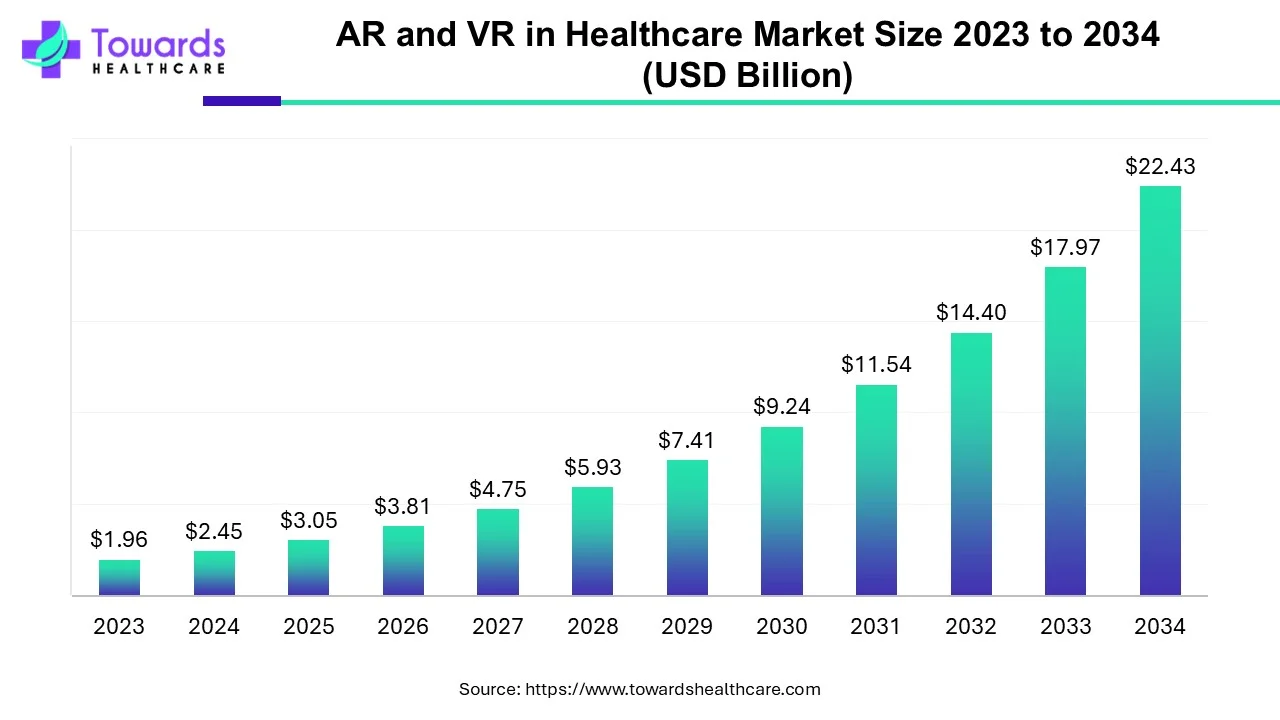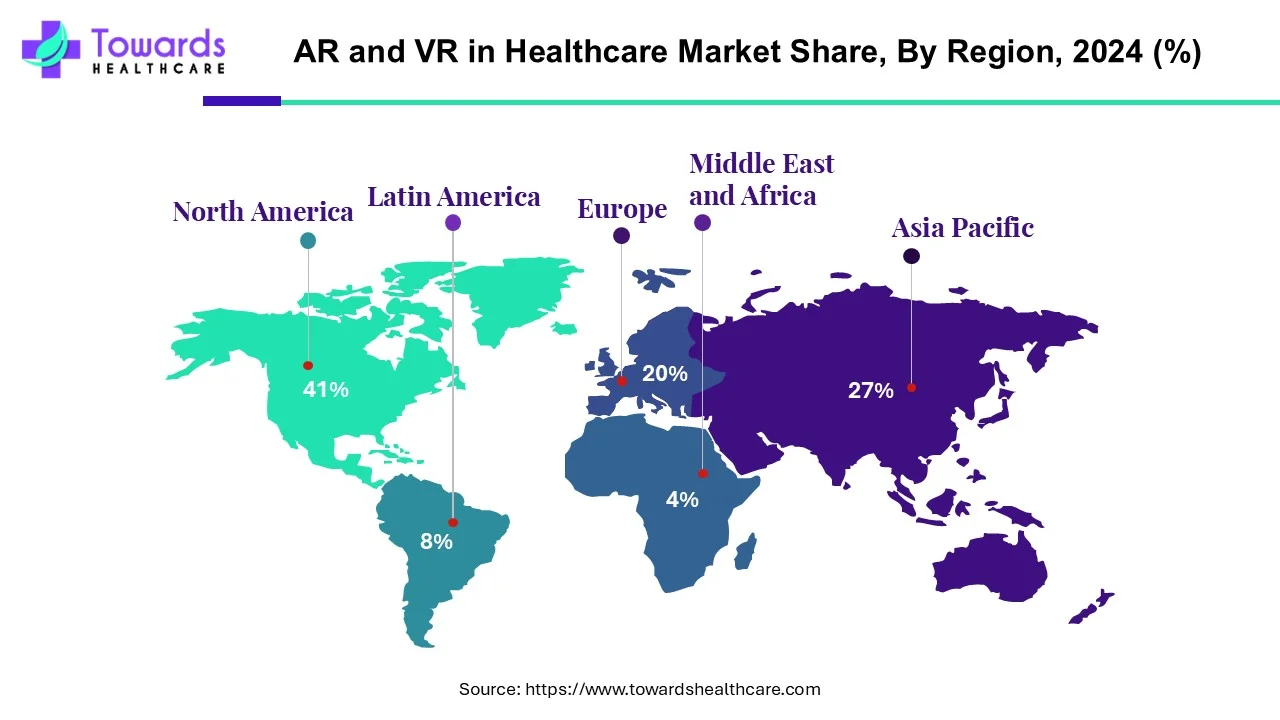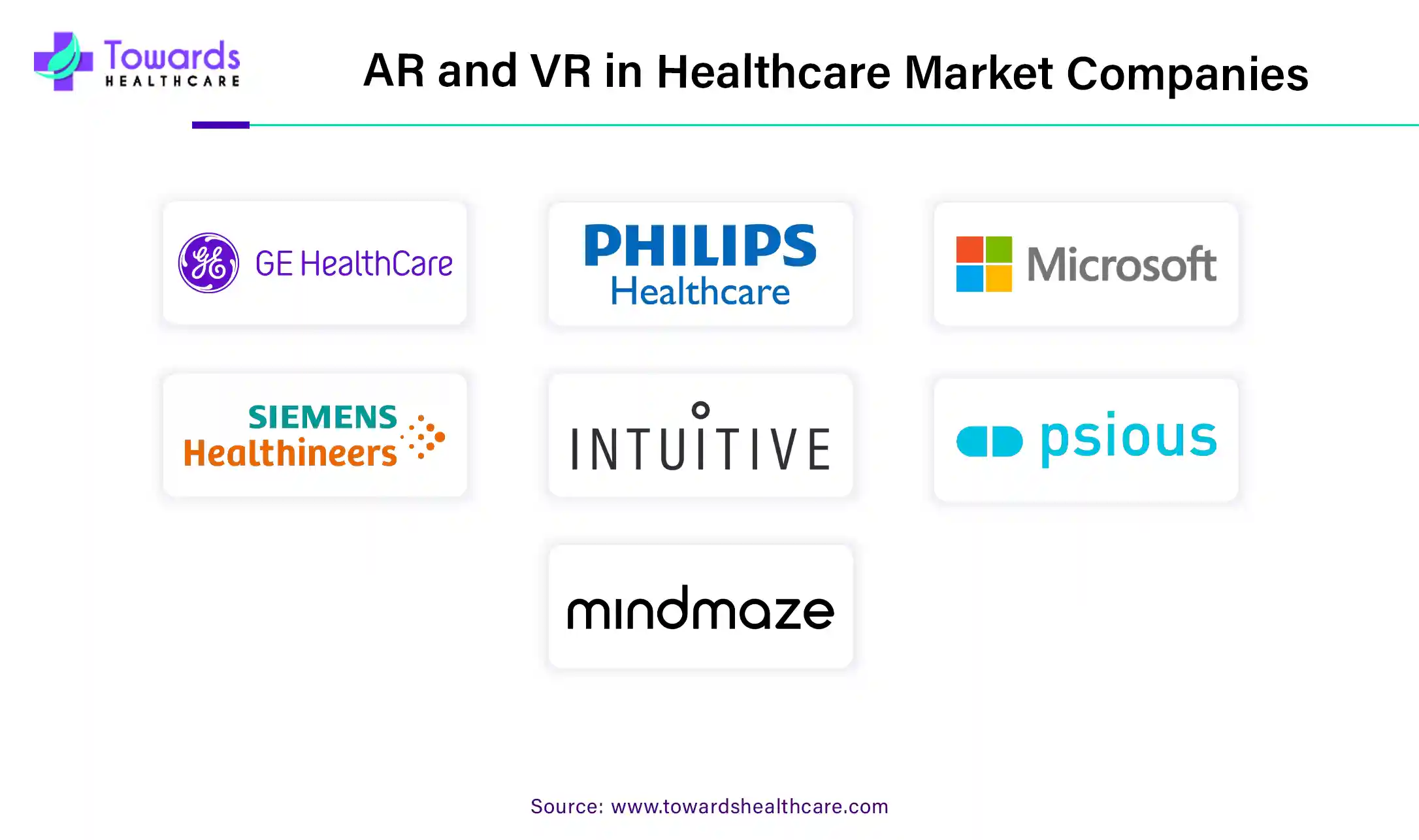December 2025

The global AR and VR in the healthcare market size was calculated at USD 2.45 billion in 2024, to reach USD 3.05 billion in 2025 is expected to be worth USD 22.43 billion by 2034, expanding at a CAGR of 24.81% from 2024 to 2034. The advent of advanced technologies, the burgeoning healthcare sector, and increasing investments drive the market.

The technology behind augmented reality (AR) enables a smart device to overlay information, films, and visuals on top of the real world. By viewing new data that has been blended into the real environment, this technology enables users to enhance the real world. The L'Oréal Makeup app, Pokémon Go, and the IKEA Place app are a few well-known instances of AR. Virtual reality (VR) is a type of computer-generated virtual reality in which a person is submerged in a digital setting. The most popular VR applications include VR chats, Volvo test drives, The North Face's Yosemite National Park hiking experience, and a huge selection of VR games.
Augmented reality redefined the healthcare industry with its expanding use of connected devices coupled with artificial intelligence. Augmented reality is a technology that incorporates digital information into a real-world environment. It provides a new approach to treatments and education in medicine. AR helps in patient treatment and surgery planning. Also, it helps to enlighten complex medical situations to the patients and their relatives.
Integrating artificial intelligence (AI) in AR and VR technologies transforms the healthcare sector, enhancing patient outcomes and providing advanced care. AI can achieve continuous and more complete real-time patient monitoring. AI and machine learning (ML) algorithms can aid in the early diagnosis and detection of chronic disorders, increasing precision and accuracy in diagnostics. They can also suggest better-personalized care solutions to patients. AI in holographic telemedicine leads to remote consultations with 3D holographic representations of doctors and patients. Several companies use AI to develop immersive VR technologies, enhancing interactivity. Moreover, AI can provide advanced healthcare solutions with the advent of voice commands in AR and VR through speech recognition. Thus, AI in AR and VR act as personal assistants to patients, reducing the workload on healthcare professionals.
While the metaverse often brings to mind gaming and entertainment, its underlying technologies are already making significant impacts in health care. These technologies include extended reality (XR), which encompasses augmented reality (AR), virtual reality (VR) and mixed reality (MR); Web3 technologies and applications, such as blockchain and virtual assets; and M-worlds, the live virtual environments where users can gather and create content.
Currently, the majority of health care applications of the metaverse involve XR. These technologies are being utilized in various diagnostic and therapeutic applications, medical training, and meetings and conferences. Additionally, companies are exploring blockchain for a range of applications, from supply chain verification to the storage and management of health care data.
The demand for cardiovascular surgeries and the use of augmented and virtual reality in surgical procedures is increasing. This is due to its characteristics like high accuracy and precision, reduced recovery time and few difficulties are major factors fuelling the AR & VR in the healthcare industry. Additionally, the increasing importance of surgical robots, the rising importance of medical visualization and the advent of several healthcare and medical-related apps are driving the augmented and virtual reality in healthcare industry revenue growth.
The use of augmented and virtual reality in operations and diagnostics is growing. The industry for augmented reality and virtual reality in healthcare is anticipated to increase as a result of systems like touch surgery, which use virtual reality to provide surgeons with a visual of the patient's anatomy and physiology in the operating room. One of the main drivers propelling business expansion over the past few years has been the increasing use of Augmented Reality (AR) and Virtual Reality (VR) technologies in surgical operations to refine surgical processes and boost the efficiency of treatment.
Additionally, AR is being widely used for medical professionals' education and training needs. AR-based learning modules enable medical professionals a more comprehensive learning experience since they offer anatomical visualization and simulation. Moreover, patients are trained using these learning modules, which helps them better grasp the course of treatment and care coordination. During difficult procedures, AR-based image viewing helps surgeons and improves their accuracy and precision.
The industry is increasing as a result of significant reasons like growing connected device use in the healthcare sector, increasing adoption of AR and VR in fitness management, and growing awareness of virtual reality exposure therapy. The usage of AR & VR in the healthcare sector is expanding as it offers sensors and semiconductor components. The semiconductor component offers processors, controllers, and integrated circuits. The sensors, on the other hand, offer a magnetometer, proximity sensor, accelerometer, and gyroscope. As a result, there are greater opportunities for manufacturers and significant international companies in the AR and VR healthcare industry. Virtual reality technology is being used by psychiatrists increasingly regularly to ease patients' anxieties. Governments in underdeveloped countries promote the makers of AR and VR technology by boosting reimbursement. In-depth, collaborative research support allowed manufacturers to produce high-end, cutting-edge equipment or instruments in developing countries.
The industry for AR & VR in healthcare may be hampered due to medical professionals' lack of training, concerns over data security, and lack of experience adopting these technologies. Additionally, as the sector has been using a paper-based system for a longer time, implementing electronic medical records can necessitate having a certain level of technological expertise. Due to a dearth of technical experts in this field, the growth of Virtual Reality (VR) in healthcare may be hindered. Nevertheless, according to industry experts, these problems might be rectified later.
Moreover, the availability of AR & VR technologies on high-end PCs, laptops, mobile phones, and computers presents the biggest hurdle for customers. Given this, it is a more complex, expensive, and unseen experience of new technologies for the common user to access these technologies. To concentrate on growth, it is necessary to address this decrease in the reach of these augmented reality technologies. Although hardware and most augmented reality software apps are enabled on high-end devices, applications can also be used on midrange devices which may lead to problems for the AR industry.
According to the availability of sensors and semiconductor components, AR & VR in the healthcare industry is becoming more and more popular. Integrated circuits, controllers, and processors are available from the semiconductor component. On the other hand, the sensors provide a magnetometer, gyroscope, accelerometer, and proximity sensor. As a result, the global leading players and manufacturers have more prospects in AR and VR in the healthcare industry.
Moreover, the adoption of cutting-edge techniques in AR and VR in the healthcare sector, such as body mapping, interactive patient information, and data visualization, creates more room for a growing industry.
A key factor in the corporate industry growth in the AR market will be significant investments made by businesses in smart manufacturing. Employing a few engineers to manage numerous facilities can be done by industries with factories spread out across the country. By remotely controlling equipment and other facilities, businesses can efficiently manage their operations due to AR technology. Enterprise AR can also be used to educate enterprise technicians and other employees, which is a significant application. The use of heads-up displays and smart helmets to provide real-time data and help workers understand construction plans will aid in their productive work.
By application type, the surgical training segment held the dominating share of the market in 2024. AR & VR were used for surgical training due to their enhanced precision. At the same time, they also offered repeated practice and showed increased accessibility. Thus, this promoted the market growth.
By application type, the mental health therapy segment is expected to show the fastest growth rate at a notable CAGR during the predicted time. The increasing occurrences of depression and anxiety are increasing the use of AR & VR. They provide an effective therapy exposure environment. Moreover, their affordability is also increasing their acceptance.
By technology type, the augmented reality segment led the market in 2024. It was used to provide information and was used for diagnostics and surgical applications. They also helped in the visualization of organ margins during surgeries. This, in turn, increased their use in medical training and rehabilitation centres as well.
By technology type, the virtual reality segment is expected to show the highest growth during the upcoming years. Their use in the management of various mental health conditions is increasing. This is increasing their innovations across various industries. Moreover, they are also being used in home care and remote therapies.
By end user, the hospitals segment held the largest share of the market in 2024. Due to the higher volumes of patients, the hospitals are utilizing AR & VR. They are being used for diagnostics, surgeries, training, and rehabilitation. The presence of advanced infrastructure is also supporting their use.
By end user, the clinics segment is expected to show the fastest growth rate during the upcoming years. The clinics are adapting to new AR & VR for therapies and surgeries. Moreover, they are offering remote care by integrating with telehealth. This is increasing their accessibility.
By user type, the healthcare professionals segment led the global market in 2024. The AR & VR were used for surgical planning. They were also used for guiding the therapy deliveries, diagnostics, and training purposes. This promoted the market growth.
By user type, the researchers segment is expected to show the highest growth during the predicted time. They are using AR & VR for research and development purposes. They offer fast testing and validation, which is increasing their use. Moreover, they are also used in clinical trials.

North America region is the dominant region in the AR & VR in the Healthcare Industry by 41% in 2024 and is expected to continue its dominance during the projected timeframe. This is due to the high demand for AR & VR owing to constant research and development activities, investments in technology, and initiative by several governments of several regions that are favorable for the industry. Many funds are offered for research and development activities to provide these platforms for the healthcare sector. Also, there has been a rise in outsourcing healthcare services due to which treatment can be affordable. Thus, the rising demand for augmented reality and virtual reality is estimated to grow in the coming years.
Asia Pacific is expected to grow at a faster rate over the projected timeframe owing to the rising adoption of AR&VR technology in the coming years. The growing awareness of the offers associated with augmented and virtual reality is expected to grow in upcoming years. Promising countries for outsourcing services connected to the production and sharing of AR and VR technology in healthcare include developing economies like India, China, Brazil, and Mexico. Due to low knowledge and population uptake, Latin America, the Middle East, and Asia Pacific are still in the early stages of development for these technologies. Healthcare spending and service quality are rising in nations like Israel and the United Arab Emirates, which is projected to further fuel higher growth in the region over the coming years.
The China AR and VR in healthcare market is experiencing significant growth because of increasing demand for telemedicine, improving healthcare standards, and patient expectations for personalized experiences. The COVID-19 pandemic spurred the adoption of telemedicine by developing new opportunities for AR and VR in remote patient consultations and virtual diagnosis.
Europe is a notable region in the AR and VR healthcare market owing to its well-established healthcare infrastructure that is actively exploring and adopting AR and VR technologies for different applications, such as surgical simulations, medical education, patient rehabilitation, and remote patient monitoring. Furthermore, the presence of more prominent AR and VR companies such as Meta, Sony, ByteDance, XREAL, and research institutions, and a tech-savvy population, also contributed to market expansion. Countries like Germany, France, and the United Kingdom have a strong presence in the AR and VR industry, spurring advancements and attracting investments.
Latin America is expected to grow significantly in the AR & VR in the healthcare market during the forecast period. The healthcare sector in Latin America is expanding, which is increasing the adoption of AR & VR. These are being used in the healthcare sector due to their scalable solutions. Moreover, with growing medical tourism and telemedicine, their use is increasing. Thus, this promotes the market growth.

By Application
By Technology
By End-Use
By User Type
By Region
Market insights predict, the botulinum toxin industry is expected to grow from USD 12.24 billion in 2024 to US...
December 2025
December 2025
December 2025
December 2025